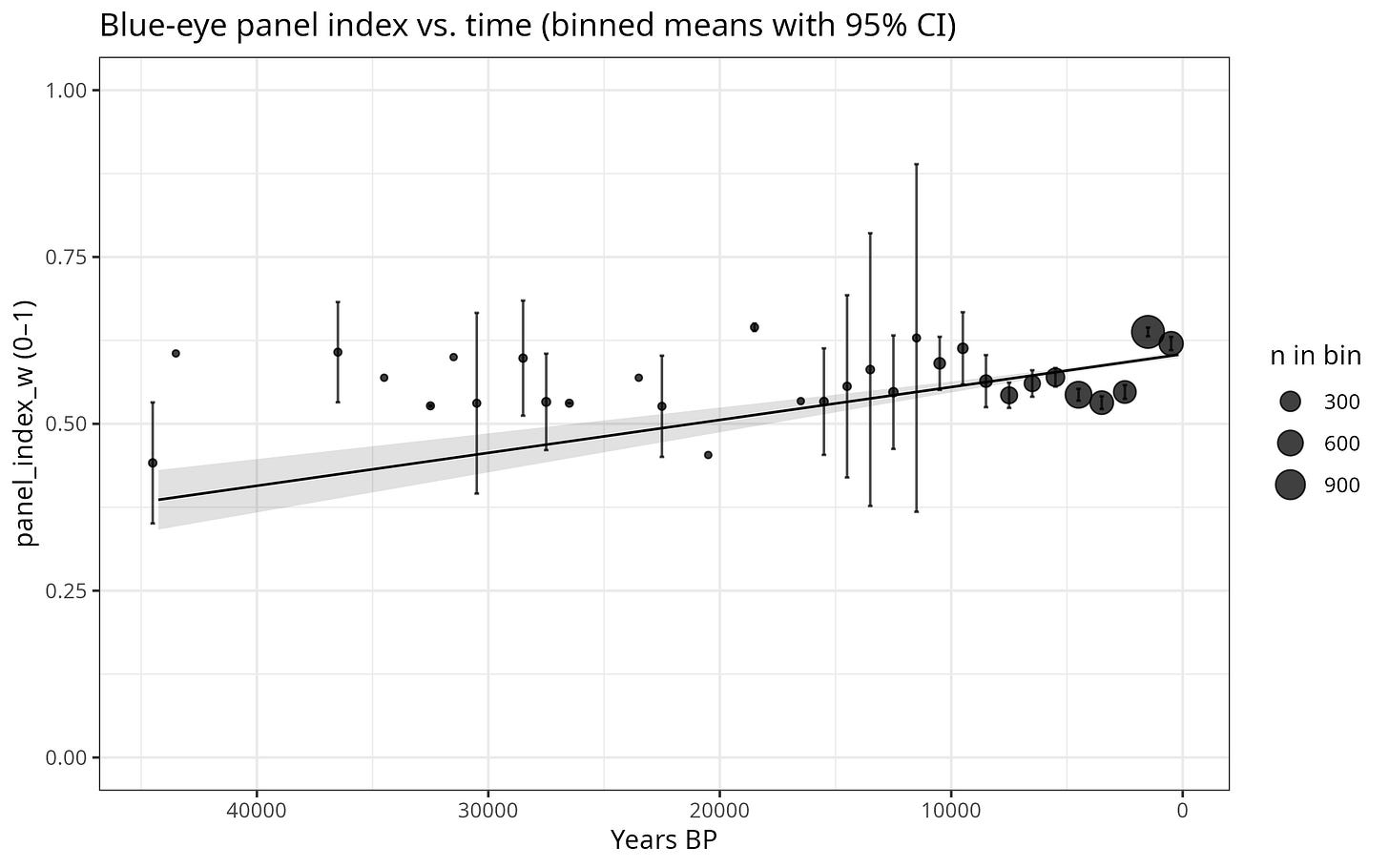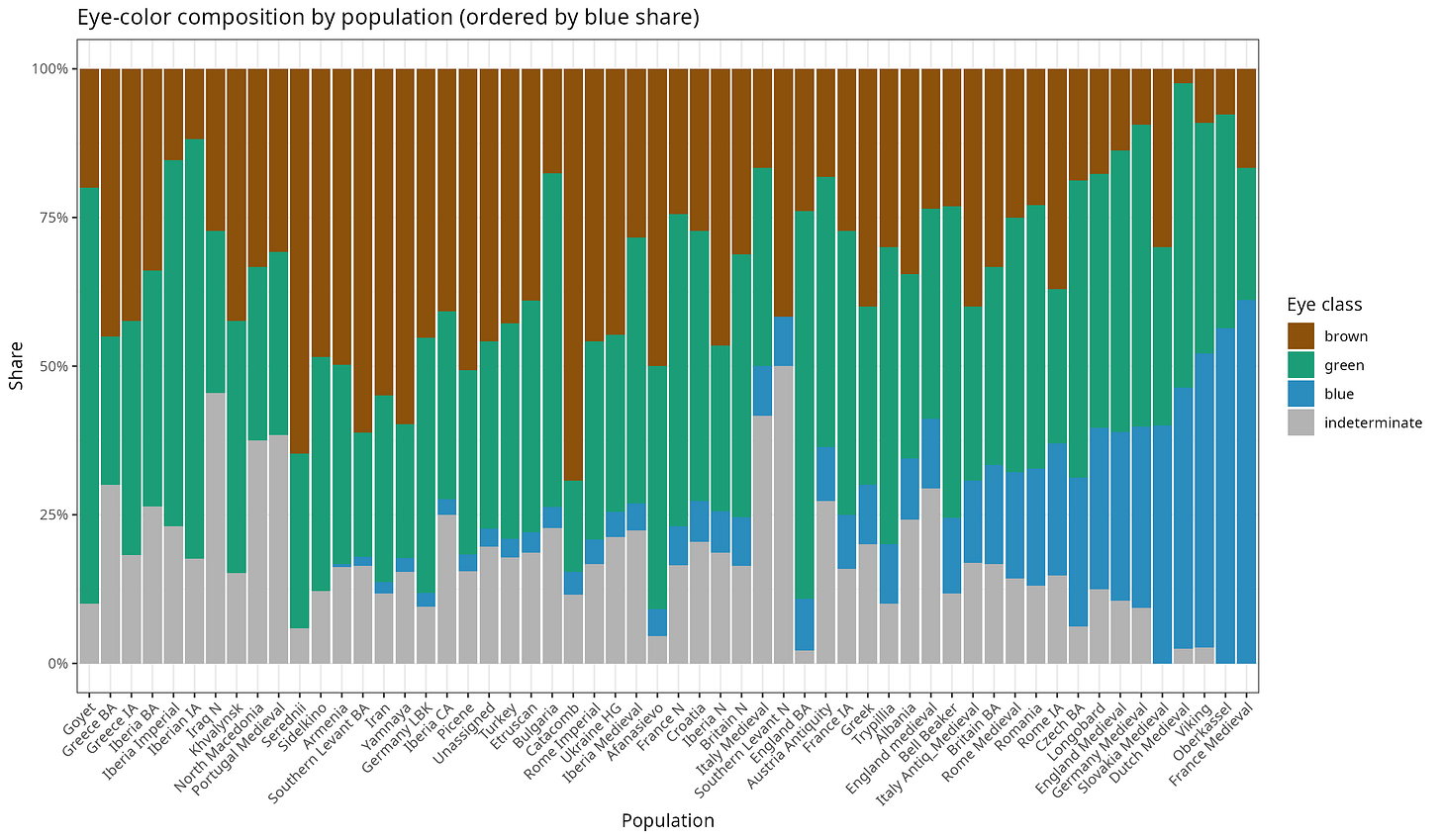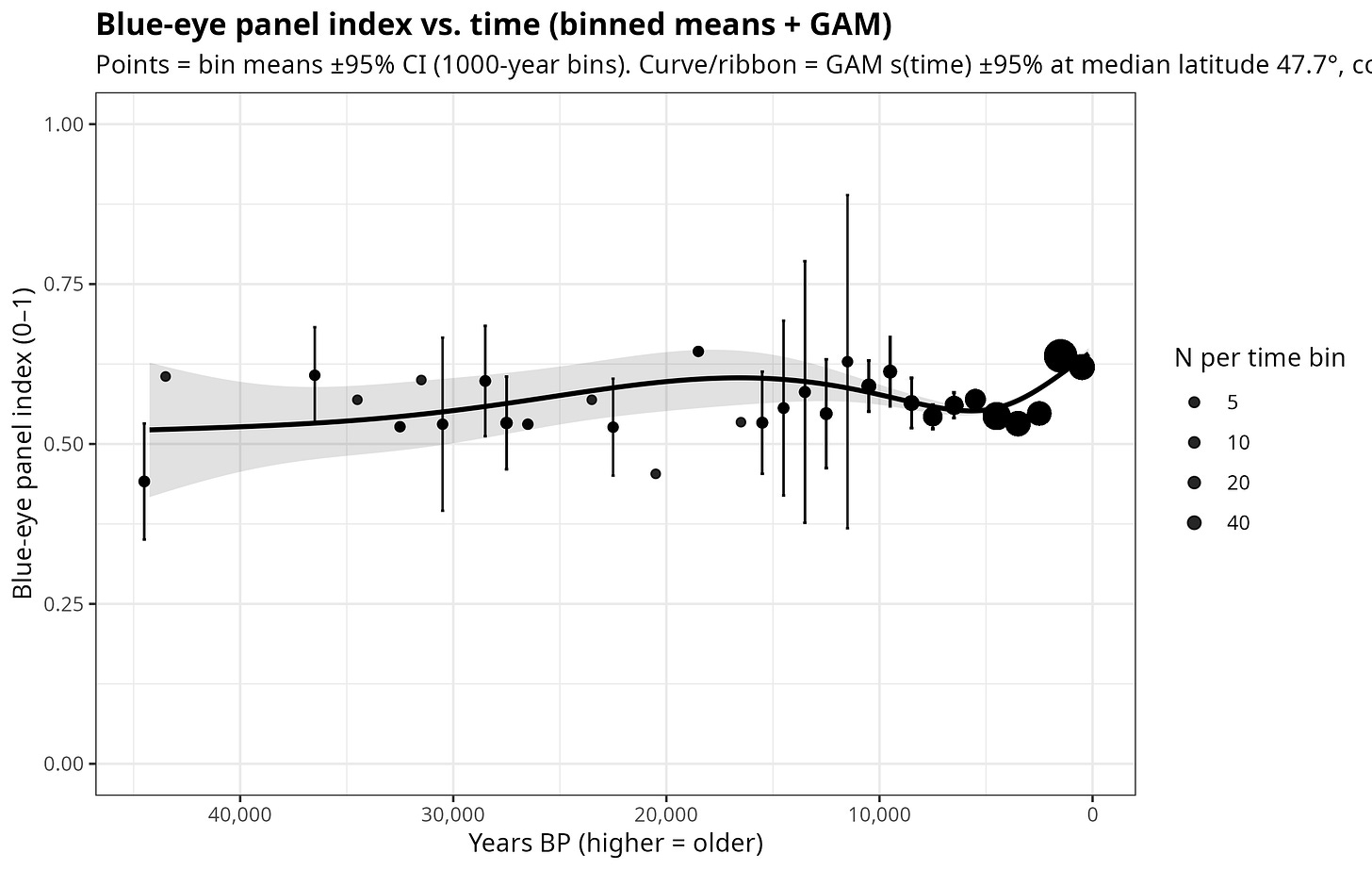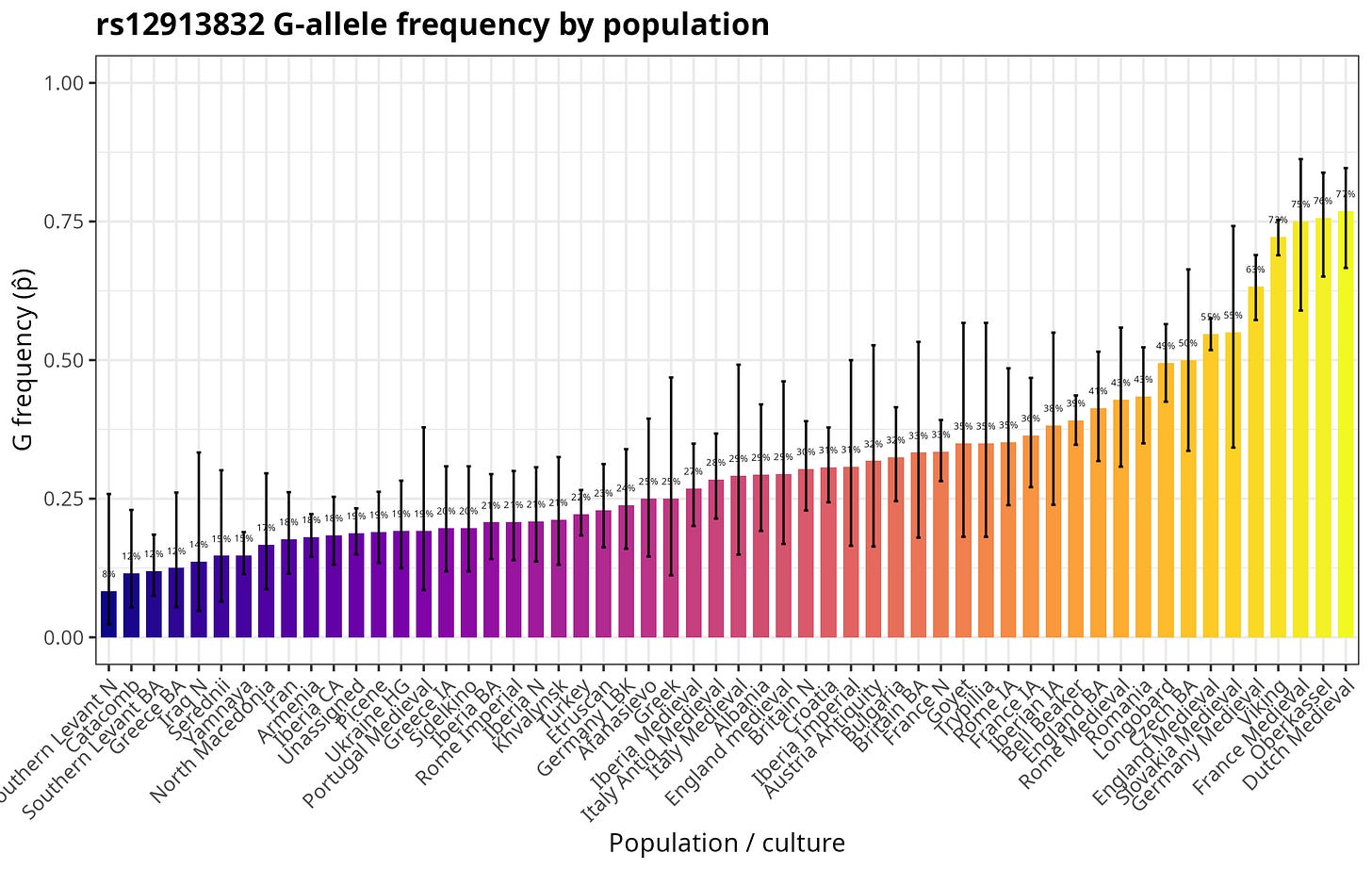The Origins and Spread of Blue Eyes in Europe: Evidence from Ancient DNA
Were Viking eyes really blue? Did Romans look more brown? And where do Europe’s first blue irises show up in the record?
How blue-eyed were the Vikings really? What about the Romans? And when did our ancestors first develop those striking blue eyes? Using 4,133 ancient genomes spanning 44,000 years, I set out to answer these fascinating questions.
The Big Questions
Popular culture paints Vikings as predominantly blue-eyed warriors, but how accurate is this image? Meanwhile, we know blue eyes are common in Northern Europe today, but when and where exactly did this trait first appear? And what can ancient DNA tell us about the Romans, who ruled an empire spanning diverse populations?
Genetics Background and The Method
The genetics of blue eyes centers on two neighboring genes on chromosome 15: OCA2, which controls melanin production in the iris, and HERC2, which contains a regulatory element. The key SNP rs12913832 lies inside an intron of HERC2, but it acts as a switch that controls OCA2. For brown eyes, both genes must work effectively, with HERC2 “turning on” OCA2 to make enough pigment. For blue eyes, a mutation at rs12913832 weakens HERC2’s control over OCA2, leading to less melanin and the appearance of blue or green eyes. The diagram below shows their relative positions.
Rather than guessing from one SNP, I scored each individual on the OCA2/HERC2 "blue-eye" haplotype (13 SNPs, DR2-weighted), and used rs12913832 as the "gatekeeper" (needs confident G/G). That produced a continuous panel index (0–1) and a conservative label: likely blue / likely brown / indeterminate. Then I modeled blue-eye prevalence with time, latitude, and genomic coverage.
DR2 is an imputation quality metric that measures how well each SNP was imputed from the available genetic data. SNPs with higher DR2 values get more weight in the scoring because they were imputed with greater confidence.
The Results: Surprising Revelations

Vikings: The Blue-Eyed Warriors (Mostly True)
55.3% of Vikings had blue eyes (95% confidence: 50.3–60.3%, n=376)
The popular image holds up! Vikings were indeed predominantly blue-eyed, with over half showing strong genetic evidence for blue eyes. Their average "blue-eye score" ranks among the highest in medieval Northwest Europe, along with the Medieval Dutch and French. The latter is likely due to the substantial Frankish admixture.
Romans: A Tale of Three Eras
The Roman story is more complex than expected:
Iron Age Rome: 22.2% blue-eyed (10.6–40.8%, n=27)
Imperial Rome: 4.2% blue-eyed (1.2–14.0%, n=48)
Medieval Rome: 21.4% blue-eyed (10.2–39.5%, n=28)
Imperial Rome stands out for having remarkably few blue-eyed individuals - much lower than both earlier and later periods. This likely reflects the cosmopolitan nature of the empire, drawing people from across the Mediterranean and beyond.
Higher blue-eye frequencies in Iron Age and Medieval Rome align with genetic evidence of increased Northwestern European ancestry during these periods. Ancestry analyses indicate that Iron Age Romans - despite having predominantly Anatolian farmer ancestry - carried significant Northwestern European admixture, likely reflecting Italic groups with steppe-derived ancestry (ultimately from Yamnaya expansions) crossing the Alps during the Late Bronze Age. A second peak appears in the Medieval period, driven by the migrations of Germanic groups such as the Longobards and Ostrogoths, who settled in Italy (Antonio et al., 2019).
The Steppe Peoples: Darker Than Expected
Despite being ancestors to many blue-eyed Northern Europeans today, the steppe peoples themselves were quite different:
Serednii Stog culture – Late Neolithic–Eneolithic, ~4500–3500 BCE. Centered in the Dnieper–Donets region of modern Ukraine, Serednii Stog is often seen as a forerunner of the Yamnaya horizon. They practiced mixed subsistence: early pastoralism (horses, cattle, sheep/goats) combined with some foraging and small-scale cultivation. They show some of the earliest evidence for horse domestication.I did not detect any individuals with blue eyes in this sample. However, since blue eyes require two copies of the allele, small sample sizes can easily give a 0% frequency just by chance. Looking instead at the underlying genetics, the rs12913832 G-allele was present at 14.7%.
Sidelkino site – Mesolithic–Eneolithic transition, ~5500–4000 BCE. Located in the Middle Volga region, Sidelkino burials represent forager–fisher communities with some contact with early herding cultures. Their ancestry was dominated by Eastern European hunter-gatherer (EHG) lineages. The rs12913832 G-allele was present at ~20%, but there were no likely blue-eyed individuals in the sample.
Yamnaya culture – Early Bronze Age, ~3300–2600 BCE. The classic mobile pastoralists of the Pontic–Caspian steppe, who spread into Europe and Central Asia. Despite their role in shaping the genetics and languages of much of Eurasia, they were overwhelmingly dark-eyed: only 3.0% (1.3–6.7%, n=169) were likely blue-eyed. Their ancestry was a mix of Eastern European hunter-gatherers (EHG) and Caucasus hunter-gatherers (CHG), which gave them intermediate pigmentation. This is consistent with the relatively high polygenic score for skin pigmentation reported in my analysis of Yamnaya genetics (Piffer, 2025), which I discussed in a previous blog post. The Yamnaya carried the rs12913832 G-allele at about 15% frequency, essentially the same as their immediate predecessors in nearby steppe cultures such as Serednii and Sidelkino.
Bell Beaker culture – Late Neolithic–Early Bronze Age, ~2800–1800 BCE. Descended partly from Yamnaya migrants into western Europe, but heavily admixed with local European farmers. Here we already see a jump in blue eyes: 13.1% (9.3–18.1%, n=229).
Key point: The Indo-European expansion spread culture and language, not blue eyes. The “northern European” phenotype of light eyes and pale skin arose later, through admixture and selection, not from the original Yamnaya.
The First Attested G-allele Carrier: Buran-Kaya (ca. 34,955 BCE)
The earliest individual in our dataset carrying the rs12913832 G-allele comes from Buran-Kaya III, a cave site in Crimea (present-day Ukraine). This is a well-known Upper Paleolithic (Gravettian-associated) site with human remains dated to around 35,000 years ago.
Location: Crimean Mountains, near the Black Sea.
Archaeological culture: Early Upper Paleolithic, often linked with the Gravettian technocomplex of Central and Eastern Europe.
Population background: These people were part of the wider network of European hunter-gatherers (Early Upper Paleolithic/WHG ancestors). The Oberkassel cluster (Western Hunter-Gatherers) that later spread the blue-eye allele is genetically related to these early groups.
The First Blue-Eyed Population
Oberkassel, Germany (~8,700 years ago): 58.9% blue-eyed
Oberkassel (Late Pleistocene, Germany) refers not to a "culture" in the archaeological sense but to a burial site complex near Bonn, in the Rhineland. The eponymous double burial with a man, woman, and dog is dated to ~14,000 years ago, at the tail end of the Ice Age. Genetically, Oberkassel individuals fall within the Western Hunter-Gatherer (WHG) / Villabruna cluster, which became widespread across western and central Europe after the Last Glacial Maximum. This ancestry is distinct from Eastern Hunter-Gatherers (EHG) further east, who carried more Ancient North Eurasian ancestry.
The Oberkassel sample group (mean date ~8.7 k BP, n = 39) is the earliest with a clear, non-trivial signal of the blue-eye allele (rs12913832-G): ~59% "likely blue" calls (95% CI: 43–73%). This is consistent with other WHG genomes (e.g. La Braña in Spain, Cheddar Man in Britain), where the derived allele was common and sometimes fixed in homozygous form. It highlights that blue or light eyes appear in western Europe well before the spread of farming, and that Oberkassel marks one of the earliest populations where the trait is clearly visible at scale.
Why Oberkassel was an outlier: These Western Hunter-Gatherers had remarkably high blue-eye frequencies (~59%) that wouldn't be matched again in Europe for thousands of years. This apparent "regression" makes sense when we consider European population history: the arrival of Anatolian farmers (~7,000-8,000 years ago) and later Steppe pastoralists (~4,500 years ago) brought waves of brown-eyed populations that diluted the WHG blue-eye frequencies through admixture. It took millennia of subsequent selection pressure to drive blue-eye frequencies back up to -and eventually beyond - the original WHG levels.
This finding is fascinating: blue eyes were established in Europe thousands of years before farming arrived.
How were blue eyes distributed across time and space? Was the temporal trend linear?
The following section takes a closer look at the distribution of blue-eye ancestry across populations, latitudes, and thousands of years of prehistory. We’ll also test whether the rise of blue eyes followed a simple linear trend, or something more complex.
Statistical Analysis: What Drives Blue Eye Frequency?
I modeled blue-eye ancestry two ways: a binary outcome ("likely blue" vs. not) and a continuous panel score (0–1). The results from both approaches tell the same story.
Binary Model Results (Raw Predictors):
Latitude is the strongest predictor. Each +1° north raises the odds of a "likely blue" call by ~16% (OR = 1.16, 95% CI 1.14–1.17, p ≪ 1e-10). Equivalently, a +10° shift multiplies the odds by ~4.28× (95% CI 3.67–4.99).
Time works in the opposite direction: as you go further back in time (i.e., higher Years BP), the odds of blue drop. The model's time coefficient shows OR per +1 kyr BP = 0.83 (95% CI 0.80–0.87, p ≪ 1e-10). Moving 2,000 years older shrinks the odds to ~0.69× (95% CI 0.63–0.76) of what they were, consistent with blue-eye frequency being lower in deep time and rising toward the present.
Coverage has a small positive technical effect (OR = 1.05, 95% CI 1.01–1.08) but is minor relative to latitude and time.
Model fit (McFadden pseudo-R² ≈ 0.167) is solid for a historical signal with noisy labels and only three predictors.
Continuous Model Confirmation:
Beta regression (0–1 score) agrees with the logistic model:
Latitude coefficient +0.024 per degree (p ≪ 1e-100)
Date coefficient −0.020 per kyr BP (p ≈ 1.7e-18)
Coverage ≈ 0 (not significant)
Interpretation: Holding coverage constant, moving north by ten degrees nearly quadruples the odds of a blue-eye call. Moving back two millennia reduces those odds by roughly 31%. Latitude dominates, time is clearly non-negligible, coverage is a side note.
Temporal trend

Where “green” fits
I use a three-class rule:
Blue: rs12913832 G/G and high panel index (≥ TH_BLUE) with ≥9/13 sites.
Brown: rs12913832 A/A and low panel index (< TH_BROWN) with ≥9/13 sites.
Green: everything in the intermediate band (typically A/G at rs12913832 with a mid-range panel score).
In other words, “green” captures light/mixed signals where the panel supports lightness but rs12913832 isn’t the full G/G state. The logistic model above targets the conservative “likely blue” label; the beta/OLS models track the continuous panel signal that also rises in groups enriched for “green.”

Non-linearity
Blue eyes didn't spread at a constant rate. A GAM (Generalized Additive Model) smooth for time (edf ≈ 4.65, p < 2×10⁻¹⁶) rejects linearity, indicating a curved- approximately accelerating - increase in the blue-eye index in the Bronze Age. A linear approximation still captures the overall direction (OR per +2 kyr BP ≈ 0.96) but understates the curvature.
The data shows:
Late Pleistocene: Blue eyes present but rare outside specific hunter-gatherer groups
Early Holocene: Gradual increase as hunter-gatherer populations expanded
Bronze Age: Accelerating spread, possibly due to sexual selection or genetic drift
The trajectory is significantly non-linear: after remaining low for much of the Late Pleistocene, the blue-eye signal rises steeply during the Holocene, consistent with accelerating spread of the allele.

Understanding the temporal pattern: The non-linear increase reflects Europe's complex population history. WHG populations like Oberkassel had high blue-eye frequencies (~59%), but these were diluted when brown-eyed Anatolian farmers and Steppe pastoralists admixed with European populations over several millennia. The accelerating increase in recent millennia likely represents selection pressures gradually restoring - and eventually exceeding - the original WHG blue-eye frequencies, particularly in northern latitudes where the trait may have provided adaptive advantages.
Modeling the rise of the G allele
Because blue eyes depend on the G allele at rs12913832 and the trait is recessive, small samples (especially when the allele is rare) often show 0% blue-eyed even if G is present. To avoid this bias, I modelled allele frequencies directly using a binomial regression.
The model explains the data very well (pseudo-R² ≈ 0.79), and the results are intuitive:
Time effect: For every 2,000 years deeper into the past, the odds of carrying the G allele drop by about 12% (OR ≈ 0.89). This shows that the allele was extremely rare in early prehistory and only increased later.
Latitude effect: Each 10° further north multiplies the odds of G by almost 4× (OR ≈ 3.7). The allele spread much more strongly in northern Europe than in southern regions.
Coverage (data quality): No significant effect, meaning the result is not an artefact of sequencing depth.
In plain terms: the G allele rose relatively late, and its expansion was strongly tied to northern latitudes. This confirms that high frequencies of blue eyes are a recent, geographically patterned development, not something the Yamnaya or earlier steppe groups carried at high levels.

Rewriting the Story
This research fundamentally changes how we understand European prehistory:
Blue eyes are ancient: much older than farming or the Bronze Age
Geography matters more than ancestry: latitude is the key predictor
Cultural stereotypes have some basis: Vikings really were blue-eyed
The Roman Empire was cosmopolitan: Imperial Rome had fewer blue eyes than its neighbours but Republican Rome was more blue-eyed, reinforcing Hollywood stereotypes.
The Broader Implications
These findings illuminate how human traits spread across populations. Blue eyes appear to have been favored in northern latitudes, possibly due to:
Lower UV exposure requiring less melanin protection
Sexual selection for distinctive traits
Genetic drift in smaller northern populations
Vitamin D synthesis advantages in low-light environments
Looking Forward
This study represents the largest systematic analysis of ancient eye color to date, but questions remain. Future research with even larger datasets may reveal:
Regional variations within populations
The role of admixture between populations
Whether other light-eye variants (green, hazel) follow similar patterns
The precise selective pressures that drove these changes
The Bottom Line
Ancient DNA is revolutionizing our understanding of human history. The blue-eyed Viking is not just a Hollywood stereotype but it's supported by genetic evidence from hundreds of ancient individuals. Meanwhile, the cosmopolitan Roman Empire shows us that ancient populations were often more diverse than we imagine.
Most remarkably, blue eyes have been lighting up Northern European faces for nearly 9,000 years, long before the civilizations we associate them with today. They're not just a modern European feature - they're an ancient inheritance from our hunter-gatherer past.
💡 Enjoyed this deep dive?
Free readers get the main posts. Paid subscribers can:
💬 Join the private chat to ask questions, discuss results, and suggest analyses.
📝 Post comments and be part of the discussion.
Read all paywalled content, including older posts.
🔬 Access follow-up studies on skin pigmentation and disease risk in ancient populations.
Deep dives and more.
This analysis used 4,133 ancient genomes with rigorous statistical methods and conservative classifications. Full methodology and supplementary data are available for researchers interested in replication or extension of this work.
References
Antonio, M. L., Gao, Z., Moots, H. M., Lucci, M., Candilio, F., Sawyer, S., Oberreiter, V., Calderon, D., Devitofranceschi, K., Aikens, R. C., Aneli, S., Bartoli, F., Bedini, A., Cheronet, O., Cotter, D. J., Fernandes, D. M., Gasperetti, G., Grifoni, R., Guidi, A., La Pastina, F., … Pritchard, J. K. (2019). Ancient Rome: A genetic crossroads of Europe and the Mediterranean. Science (New York, N.Y.), 366(6466), 708–714. https://doi.org/10.1126/science.aay6826
Piffer, D. (2025). Why Were the Yamnaya so Successful? An Evolutionary Polygenic Approach. Mankind Quarterly, 65(4), 510-532



I think blue eyes are a whole lot more polygenic than this panel assumes. You might have heard of the SLC24A5, SLC45A2, MC1R, IRF4, and TYR/TYRP1/TYRP2 mutations which have complex and hard to disentangle effects across all three pigmentation domains (people will tell you MC1R and TYR(P1/2) affect just hair color, or that SLC24A5/45A2 affect just hair color, but they are wrong, changes in the melanocyte -> melanosome regulatory pathway are pleiotropic across all three domains). But recent evidence shows that the number of genes that affect these traits is even larger than just those, possibly in the domain of 10s of thousands of SNPs across 150+ genes, including exotic ones like QKI, NCOR1, LRMDA, RAB27A, BNC2, and countless others. What's more, most of these "exotic" variants underwent strong differential selection between Europeans, Africans, and Asians (see https://pmc.ncbi.nlm.nih.gov/articles/PMC10901463/). Some of them probably have their effect sizes "masked" in GWASs because they have such high linkage disequilibrium with more canonical genes – but this was not necessarily always the case, and ancient populations may have had fully depigmented phenotypes while having genotypes with none of the "canonical" mutations we focus on today, but only these weird "masked" ones.